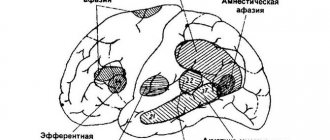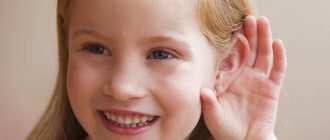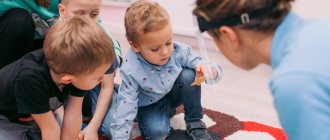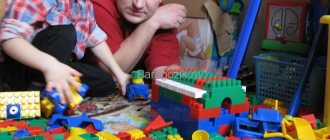Sensory integration therapy (sensory integration) is a set of therapeutic activities aimed at developing all the child’s senses.
During exercise, the nervous system receives signals from all analyzers - auditory, visual, vestibular, gustatory, as well as from tactile and proprioceptive receptors, processes the received sensory information and uses it in purposeful activities.
If a child, for any reason, has a disorder in the processing of sensory signals, this leads to dysfunction in motor skills, cognitive development and behavior. Therefore, sensory integration methods can (and even need) be included as an integral part in children's classes with any teachers. Through sensory development, the child receives a mechanism for understanding the world, so the importance of stimulating sensory perception of the world cannot be underestimated.
Comfortable contact with the world
Sensory integration is the ability to put together signals from the senses. Thanks to this process, the baby harmoniously integrates into the world around him and learns about it. Sensory integration has three levels, which are mastered by the child sequentially:
- Bodily sense of self: understanding the position of one's own body (proprioception), the sense of balance and movement (vestibular sensations), and the sense of vibration.
- Vision, hearing and tactile sensations, including smell, taste and touch.
- Higher nervous activity: speech, counting, self-esteem, attention, ability to regulate behavior, creativity.
The child begins mastering the first level even before birth: he feels the movements of the mother’s body, his own movements. The development of sensory integration continues until primary school age.
A correctly mastered basic level provides a reliable foundation for the second. The child grows and becomes able to perceive more data transmitted by the senses. Social behavior is then formed on the basis of sensory integration.
How to adjust
Here are several basic types of activity that can be combined depending on the specific manifestation of sensory disintegration.
What if something went wrong?
Sensory integration dysfunction manifests itself in two forms: hypersensitivity, when the child reacts negatively to stimuli that are calmly perceived by others (usually tactile or auditory signals), or hyposensitivity, when the child does not perceive a signal of normal intensity.
Parents may notice signs of sensory integration disorders if the child:
- starts to roll over, sit, stand, walk late;
- avoids certain textures (for example, sand, paper, plasticine), refuses finger painting, reacts sharply to certain sound or auditory stimuli;
- incorrectly, awkwardly takes a spoon, pencil, felt-tip pen;
- reacts with indignation to loud sounds or bright lights;
- does not hold attention well: when rewriting text, regularly skips letters or entire syllables, does not listen to the end of the task;
- constantly confuses right and left;
- the child is unable to ride a bicycle, he avoids swings or carousels, or, conversely, is too keen on them;
- avoids active movements, clumsy;
- moves too much and quickly;
- there are fine motor skills impairments;
- there is a delay in speech development;
- cannot stand it when another person comes too close, does not play with other children;
- has difficulty learning, especially reading and writing, gets tired quickly;
- cannot concentrate, impulsiveness is often manifested in behavior;
- cannot plan his activities and behavior.
All of these signs may indicate a sensory integration disorder, or they may have other causes.
Sensory development of children with Down syndrome at an early age
How and what to do with your child in the first 9 - 12 months of life to develop sensory integration.
Visual stimulation
Communicate with your child from birth, talk to him, sing songs, rock to music, looking into his eyes; bring your face closer to the child’s face so that he can see you better.
Babies focus their gaze best on bright objects located nearby. What attracts them most is the contrast of white and black, as well as the color red. In addition, children from birth have an increased interest in human faces. Let your baby look at your face and facial expressions more often while you talk to him or sing songs to him. Try to get your child to concentrate on your face for as long as possible: make faces, make all sorts of funny sounds. Place a mirror on the bed, lie down next to the child and make faces, let the baby look at your face and his own. Imitate your child's facial expressions.
If the child does not look at you, does not look you in the eyes, gently move his head so that he is more comfortable. (Some mothers recommend placing the baby on your lap.)
Babies with Down syndrome have low muscle tone and later begin to hold their head, so make sure that your child is comfortable looking at your face. Connect your brothers and sisters. Gradually ensure that the baby can concentrate as much time as possible on the “spectacle” offered to him.
Move closer to the baby's face and then move away. Do this slowly.
Sometimes you can play pranks - put on a funny hat, glasses, or stick a sticker on your cheek or forehead. The baby will be wondering: what will he see next time?
When the baby has mastered the “eye to eye” look and can keep his gaze on your face, play hide and seek with your child and their simplest version of “peek-a-boo,” when you hide your face behind your palms, or the baby’s face under a diaper.
The ability to follow a moving object with your eyes does not arise immediately. Give your child the opportunity to learn this with the help of bright objects that make interesting sounds. For example, move a toy dog left and right in front of your child’s eyes and say “aw-aw.” For an older child, you can blow soap bubbles and watch them fly, or play with a balloon. Gradually ensure that the child can spend more and more time looking at the object and observing moving objects.
To train the ability to fix your gaze on an object, at first you will simply have to name each object on which the baby’s gaze accidentally lingers. “This is a doll”, “Here is your bottle.” Look for the desired item with your child: “Where is the bottle? Here she is! Here's a bottle! Next, the child must learn to look at you, trace what you are looking at, and also pay attention to this object (“Look at that bird!”). This skill will be useful in the future for the main stage in the development of speech - when you tell your child the name of this or that object.
Take a brightly colored toy, such as a ball, and hold it near your face; when the child looks at you, slowly move the toy away from your face and follow it with your eyes. Comment on the “going away” of the toy by modulating the volume and pitch of your voice, this will encourage the child to follow the moving object. Emotionally name the word, repeat the name repeatedly: “Ball, ball, look at the ball!”
All parents want to see a response. Some babies with Down syndrome will react very animatedly to everything, while other babies will lie indifferently. Don’t give up, try to provoke a reaction, sooner or later you will see interest in the child’s eyes! Gradually, he will learn to focus his eyes, look at your face, and enjoy you if you spend more time with him, giving him the opportunity to learn how to do this.
For visual stimulation, play with a switch, turning the lights on and off in a dark room (dark-light).
If your child has vision problems, be sure to consult a specialist.
Auditory stimulation
Babies with Down syndrome will have to learn not only to hear a variety of sounds, but also to concentrate on their perception (similar to how babies learn to focus their eyes). Try not to present your child with too many different sounds at any given moment. Many children are disturbed by sounds that are too loud, while others find it difficult to distinguish the most important sounds (the mother's voice) from the background noise.
Try to imitate the sounds your baby makes. Repeat it as accurately as you can, and then play around repeating it in a high, thin voice, then in a low, rough voice.
Establish for your child a connection between an object and the sound it makes. Taking a toy duck, call it “duck, duck”, tell the child: “The duck says: quack-quack. What does a duck say? Quack quack". Attract toys in the shape of animals, children's musical instruments (ding-ding bell, bam-bam drum). Of course, the baby will not be able to repeat this after you for a long time, but the stimulation will not be in vain.
Prepare more rattles and bells that make a variety of sounds. When playing with them, let your baby listen and compare these sounds, but do not forget to also give him the opportunity to extract them himself. Gradually he will establish a logical connection between the sound source and the sound!
Sew bells onto a hair tie and place it on your baby's arm or leg. He will understand that sounds are heard when he moves his arm/leg. Just don't leave your child unattended with this toy!
Call your child by name often. If he doesn't respond to his name yet, attract his eye with a brightly colored toy and call him by name again several times.
When talking to your child, hold your face so that he can see your articulation.
Repeat after your child the sounds he makes when he cries or gurgles. Repeat what he “said”, then pause, as if waiting for his answer. This should be your golden rule. When talking to your child while dressing, bathing, etc., always pause, as if waiting for an answer from him. If he makes a sound, respond naturally, such as, “What are you talking about!” or “Really?” Try to make your conversation seem like a real conversation.
It is important to ensure that the child pays attention to the sounds around him. Play different music for him, sing songs, recite rhythmic poems. Songs and poems with actions are very good in this regard (“Here comes the cow”, “Teddy bear”), they teach the child to pay attention to what he hears.
When working on auditory perception, it is important to learn to determine where the sound that attracted the child comes from. To teach him this, use various sound sources: whistles, bells, crumpled cellophane, castanets, maracas, clap your hands, and so on. First, make the sound in the child's field of vision, directly in front of his face. Then move the sound source to the right or left of the child. If he doesn't pay attention, tell him: “Listen! What is this? Well, look!” Train your baby to follow with his eyes and then turn towards the source of the sound. If your baby has difficulty turning around, sit him on your lap so that the source of the sound is out of his field of vision. Listen to the sound, say: “Oh, what is this?” and turn the child yourself to face the source of the sound. Reward your baby with a smile and a hug for turning around. Play these small games several times throughout the day. Talk to your baby or make funny noises as you move around the room.
The child needs to understand which sounds make sense, which sounds need to be paid attention to (mother’s voice), and which sounds are not necessary (the noise of the refrigerator, the ticking of a clock). If the baby does not learn this, “overload” and even “switching off” of the sensory system may occur. At an older age, this skill will come in handy more than once, for example, during school: he needs to listen to what the teacher says, and not what his classmates say.
Give your child the opportunity to listen to the voices of relatives on the phone. Comment: “This is a woman speaking. Do you hear, it’s a woman!” Talk to your baby or make funny noises as you move around the room.
Collect a “sound box”. There you can put a whistle, a bell, a pipe, a maracas, two wooden spoons, a Kinder Surprise container with beans or cereal inside, and so on. Play with your child.
Try to gradually increase the period of time during which your baby can focus on active listening: sing him longer songs, talk to him longer.
Many parents talk to their kids the way they need to without thinking about it. However, we still note how exactly you should speak to a baby: in a high (thin) voice, in short sentences, much more slowly than usual, repeating words and phrases many times. When the child gets older (2-3 years), you will no longer squeak when talking to him, but the need for short phrases and repetitions will not disappear for a long time.
If your child has any hearing problems, be sure to consult a specialist.
Tactile stimulation
A small child experiences the world through touch. It's no coincidence that babies put everything in their mouths. You should give your baby the opportunity to “examine” with his mouth objects of various shapes and textures, soft and hard, cool and warm, rubber and plastic, etc. Every time a child licks or sucks a new toy, his brain receives a signal about what qualities this object has. So, allow your child to put toys in his mouth and explore them, because this is very important for speech development. Of course, remember about hygiene, wash toys thoroughly before use. But don't deprive your child of such an important experience.
If the baby does not put objects into his mouth, you can use a soft toothbrush to massage the baby's gums, inner cheeks and tongue.
Buy or make a special book in which on each page there will be a piece of some material that you can touch (pussy fur, sandpaper, etc.). It will be useful to you in the future when you work on expanding your child’s vocabulary (soft, fluffy, rough...).
Allow your child to play with objects that feel different, such as jelly, whipped cream, or cooked pasta.
Touch your baby with objects of different textures. Rub the baby's face with a soft and then a harder towel, for example. For variety, use massage oil or lotion.
Brush your child's teeth and gums with a special children's toothbrush.
Rub and massage your baby's body. You can gently or quickly rub your baby's face, cheeks, and tongue with a clean towel. Touch the baby's face with cotton wool, a piece of velvet, a piece of hard fabric... Play games with the child that require touching the face ("Forest, clearing, slide, hole..." and others). Wash your child’s face by touching different parts of the face (“water, water, wash my face.”
Encourage your child to imitate your facial movements: licking lips, clicking his tongue, etc. Try to keep your face close to the child's face so that he can clearly see what you are doing.
Try to imitate your child's actions. If he slapped the table, you slap too. Then he will be more motivated to imitate your actions. Try different activities and encourage your child to imitate you. Choose actions that the child can perform (clap-clap on the table, stomp on the floor with a foot, splash-splash on the water in the bathroom). At first, you can help the child, wave his arms, walk with his legs, etc., so that he understands what is required of him.
I will say a few words about such an important activity as feeding a child.
Remember that feeding is important not only in itself, for the growth and development of the child, but also as a way to train all those organs that are needed for speech, as well as for communication between the child and the adult!
Often, parents of children with Down syndrome encounter problems establishing feeding. This may be due to low muscle tone (hypotonicity). If it is difficult for your baby to close his lips on the nipple, rub his lips, massage his chin and the area under it. When your child is not eating, you can try placing a piece of ice on his mouth to help him feel his lips and tongue. You can try massaging the tongue: tap it rhythmically with a papilla or a clean finger. When the tone of your tongue improves, you will feel it. Then you can try to stimulate the tongue to move up and down, left and right, to encourage the tongue to bend - to form.
Gradually, the baby becomes aware of exactly how his lips, tongue and other organs move.
When a child begins to spoon feed, it is recommended to use a small and shallow spoon, giving small “portions”. Try to give your child food of varied texture to stimulate tactile sensations inside the mouth: baby instant porridge, fruit puree, oatmeal, cottage cheese, mashed potatoes, then pureed meat, yogurt, soups. As soon as the child is ready to absorb more solid foods, you should provide him with the opportunity to learn to chew, make and improve the movements of the tongue in the horizontal plane.
Children with hypersensitivity may be picky eaters. They may refuse to eat a dish for which you mixed several ingredients. They may prefer only hot or only warm, refusing food at other temperatures.
How and what to do with a child from one year to three years.
In everyday life, you need to continue to engage in sensory stimulation, form sensory standards and consolidate cognitive skills. Such as:
A child's acquisition of the concept of quantity.
To do this, you should draw the child’s attention to objects of various sizes that arouse the child’s interest and attention: ask him, using oral and sign language, which car he wants to take, large or small; compare two rings from the pyramid and choose the big one to string first;
play with the big and small bear, put them to sleep in the big and small cribs; learn how to select lids for two pots according to size, etc.
Child's acquisition of the concept of form.
To do this, you should draw the child’s attention to objects of various shapes that arouse the child’s interest and attention: balls, cubes. Use joint play with your child and comment that “The ball is rolling. Look how. Roll the ball”, “The cube doesn’t roll. Let's put a cube on a cube. It turned out to be a tower,” etc.
To teach the correlation of shapes, we use various sorters, inserts with geometric shapes, Seguin boards, Montessori frames, etc.
A child's acquisition of the concept of color.
To do this, you should draw the child’s attention to objects of different colors that arouse the child’s interest and attention.
Sort by color balls of two colors, clothespins, Frutonyanya food caps, cubes, Lego parts, etc.
Development of the sense of smell:
To do this, draw the child’s attention to the smells around him. In the absence of allergies, it is necessary to stimulate the perception of various odors (citrus, floral, vanilla, cinnamon, etc.)
Development of taste sensations:
To do this, offer your child, if there is no food allergy or other restrictions, foods of different tastes (sour, sweet, bitter). Let them try foods that have contrasting tastes, for example, lemon and sugar, and teach them to distinguish between them.
Remember that sensory development must be combined with the child’s physical development: training muscle strength, coordination, endurance and balance. Organizing exercises and daily physical education has a beneficial effect on the development of children with Down syndrome, since the formation of gross and fine motor skills is an integral part of sensory integration.
Teaching children with Down syndrome to use basic social skills in everyday life plays an equally important role. If you do all the household work for a child, he does not develop the necessary skills for self-care, no motives to perform any action are formed, as a result, new neural connections are not formed, and further development is inhibited.
When learning self-care skills, sensory analyzers, cognitive skills, speech, the ability to use gestures and much more develop.
It is worth noting that it is in a natural environment, and not an artificially created one, that a child will develop better, assimilate and remember the necessary information.
Creating conditions for sensory development plays a huge role in the development of children.
For tactile, vestibular and proprioceptive stimulation, the use of special equipment is effective:
- weighted blankets, hammocks, trampolines, tunnels, carts, exercise balls, dry pool, etc.
- natural materials: sand (kinetic, regular), chestnuts, sea pebbles, cones, beans, water, etc.
- a variety of prickly balls, brushes, sponges and much more that are used in everyday life.
It is important to understand that the child himself intuitively chooses those types of sensory stimulation that he needs for development. We, adults, must only give him the opportunity to explore the potential of his own body, form adaptive responses and, most importantly, find the time and place for this.
Scientists have noted that even ordinary hugs have a great positive effect on the sensory development of a child.
It is necessary to carefully consider the child’s needs for play and not replace it with early learning, computers and television. First, the child must try everything, touch, ruffle, experiment with all the objects that surround him, move in space, crawl, crawl or climb on everything that beckons - only in this way will he gain the experience necessary for development.
Recently, more and more often the lives of children of the generation of the sixties and seventies are compared with the lives of today's kids. And they come to disappointing conclusions. The absence and insufficiency of sensory experience and the replacement of natural games for children with computer games significantly increase the sensory disintegration of children and negatively affect the development of cognitive skills, imagination, and fantasy. How many of today's preschoolers will be able to figure out how to make all the equipment for playing shop from scrap materials and “deliver” products from sand, clay, leaves, sticks and other garbage and dirt there? How many three-year-old boys will be able to figure out how to install spoon to a truck to make a snowblower? How many kids will be able to do all this before their parents buy them shiny plastic toys in which everything has already been done for them - toy bags, store scales, and all kinds of cleaning and other equipment?
As stated above, all children need sensory integration. Of course, a child with motor impairments or visual impairments will need additional help from specialists to give him the necessary sensory experience, to help him “explore” the environment, the body diagram, to understand how he can move in space, interact with the environment.
During classes, constantly talk to your child, even if he cannot answer, try to understand and comment on his signals, feel his intentions and desires. Always rely on his strengths, note any of his attempts to gain independent experience, praise his actions, rejoice at his successes. Draw your child's attention to positive changes rather than negative ones. The more the child does not understand you, the more effort you put into his development. If these recommendations are followed, even children with a complex defect structure will experience positive results.
Centers for the development of sensory integration successfully operate in St. Petersburg, where many programs for the sensory development of children with special needs are effectively implemented. This is the well-known Space for children and parents “Kashtan” and the Center for helping children with disabilities of perception and adaptation “Nanny Owl”.
Bibliography
- D. Ayres “Child and sensory integration”
- E. Yanushko “Sensory development of young children”
- L. Kumin “Book about the early development of speech in children with Down syndrome”
- Downside Up website materials
When and how to treat
Sensory processing dysfunction is common in children. In Europe and North America, they affect from 5 to 30% of preschoolers, in Russia - 19.7%. Although the statistics, in our opinion, are underestimated. They are observed 4 times more often in boys than in girls. In children suffering from neuropsychiatric diseases, from cerebral palsy to ASD, they are detected with a frequency of 15 to 92%. That is, sensory integration disorders can be independent and symptomatic. In any case, they bring discomfort to children, have a negative impact on the formation of their personality and require correction.
The insidiousness of this condition is that it is detected late because it is disguised as other problems. As a result, the neurologist at the clinic spends a long time treating the wrong thing, and time is wasted. The child continues to misinterpret data from the senses, and violations accumulate like an avalanche.
Sensory integration disorders can be corrected, and unless they are a symptom of another disease, they will go away without a trace. It is ideal to identify the problem and begin solving it before the child reaches the age of 3 years. A neurologist, speech therapist, neuropsychologist, and defectologist can help. The sooner the cause is identified, the easier it is to teach the child to harmoniously perceive various stimuli, and the faster he will return to the path of proper development. After all, if the brain perceives signals from the senses inconsistently, it will not be possible to sense a holistic picture of the world and oneself in this world. This will inevitably affect the child’s communication, his development and, possibly, his entire destiny.
General recommendations
For advice, contact a specialist from our center. We will provide you with the primary necessary information by calling +7(921) 995-61-57, and at the appointment we will conduct a comprehensive diagnosis and draw up an individual plan for sensory therapy.
When are the first results visible?
The speed of obtaining results and effectiveness depend on the child’s capabilities, the severity of the defect and overall potential. The level of skills of a child with special needs will differ from the “passport” age, and learning new skills and development occurs more slowly. Therefore, parents will have to be patient.
Some children do not develop new skills and knowledge without special training, so you should not prematurely make “excessive demands” on a child or underestimate his real capabilities.
Additional home supervision is required to reinforce some of the skills acquired. The specialist will tell you more about this when he gives you your homework.
The program is designed for a year due to its correctional and developmental orientation. The required number of classes is 2-3 times a week. The dynamics of children's development is monitored by monitoring the child's socio-psychological development 3 times a year.
Come and we will teach your child to be more independent and explore the world around him with pleasure.
“Why does a child need a neuropsychologist?” — we tell you in detail when a child needs to be shown to a neuropsychologist and how he can help.
How to help a special child learn?
Special children also want to learn. But they don't have the skills that allow them to do it with pleasure like other children.
Unlike an adult, a child’s nervous system is trainable and can compensate for missing skills.
With a systematic and consistent approach, which is mastered by a specialist, a child can be taught to communicate with the environment. From a huge number of simple exercises, the psychologist will choose those that will help a particular child and draw up a program for sensorimotor development.
How do children with special needs develop?
A typically developing child learns and masters skills naturally, at the level of his age group or peers, which cannot be said about children with developmental disabilities. The formation and enrichment of such a child’s sensory experience, his sound and visual perception, as well as cognitive activity - attention, memory and thinking - is difficult.
The child cannot isolate individual elements from the environment or generalize them, and undeveloped perception and specific memory deficiencies make it difficult to get to know the world. Therefore, children with special needs often do not correspond to generally accepted parameters of age-related development.
Accordingly, correctional work when preparing a child for school requires considerable effort, and the educational program must be adapted individually for each child.
Why is the program interesting for a child?
The program provides for development and education through learning, play, music, movement, and visual arts. This format evokes positive emotions and thus improves the perception of new information.
If a child perceives a correctional activity as too difficult and tiring, he will refuse to participate in it. Therefore, for motivation to appear, the activity should look like a game or entertainment. This is equally true for ordinary children and for children with special needs.
What are the benefits of exercising?
In classes on the development of psychomotor skills and sensory processes, a child with developmental disabilities can learn:
- recognize and compare objects according to given characteristics;
- distinguish objects by shape, size, color, functionality;
- highlight the signs and properties of objects and phenomena;
- navigate in space, determine the sequence of events;
- independently coordinate your movements and actions;
- see time frames.
All this develops independence in him and forms the prerequisites for adaptation in society.










